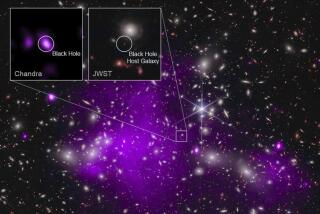Large Hadron Collider finds long-sought signs of rare particle decays
Smashing protons together in search of strange particles, scientists at the Large Hadron Collider near Geneva say they’ve discovered signs of particle decays that have long been predicted, but have never before been seen.
The decay pattern of the two B mesons, described in the journal Nature, could help researchers test the limits of the standard model of particle physics and probe unexplained cosmic phenomena, including the existence of dark matter and the dearth of antimatter in the universe.
Three years after the dramatic discovery of the Higgs boson -- a find that earned the theorists who predicted its existence a Nobel Prize -- CERN’s Large Hadron Collider has been retrofitted and upgraded to search for particles at even higher energies than before.
“From the scientific standpoint, this is big, heady stuff. All the puzzles of physics could fall into place or they could just remain mysteries based on what we learn from these decays,” said study co-author Joel Butler, a member of the collider’s Compact Muon Solenoid (CMS) experiment and an experimental particle physicist at Fermilab in Illinois. “This is kind of a fantastic time in physics, where many mysteries might get resolved.”
That’s because, while the Higgs boson fits neatly into the standard model, scientists know that the model does not truly explain the reality around us. It cannot account for dark matter -- the invisible, untouchable stuff that can’t be directly detected but whose gravitational influence defines the structure of the cosmos. Nor does it describe dark energy, the strange repulsive force that is causing the universe to expand at a faster and faster rate. It certainly can’t explain what happened to all the antimatter in the universe. If antimatter was created in equal or near-equal amounts to matter, then all (or at least most) of the matter and antimatter should have annihilated each other by now. The stuff we’re made of should not have survived -- or at least, not in such high amounts.
The standard model also “makes a worrisome warning that the universe is probably unstable, ready to collapse in a ‘big crunch,’” Daria Zieminska of Indiana University in Bloomington wrote in a commentary on the paper.
So scientists smash protons together to watch the shower of decaying particles that result. Like detectives probing the holes in a suspect’s alibi, they’re trying to find discrepancies that don’t match the standard model’s story.
Some particles are easier to interrogate than others. The scientists decided to examine neutral B mesons, short-lived particles that quickly decay into other products. Just like more well-known particles such as protons and neutrons, mesons are composed of quarks, which come in six flavors: up, down, strange, charm, top and bottom. Different mesons have different combinations of quarks.
Since the standard model makes some pretty clear predictions about these B mesons’ behavior, they’re a good place to start looking for discrepancies.
The scientists used data from the proton-smasher taken in 2011-2012. They searched through the resulting subatomic rubble for signs of two neutral B mesons: The strange B meson, which is made of a bottom antiquark and a strange quark; and a non-strange B meson, which is made of a bottom antiquark and a down quark.
B mesons haven’t been directly seen, but their fingerprints can be lifted from the particular shower of particles into which they decay.
The model predicts that the strange B meson should decay into two muons at a rate of about four per billion, and the non-strange B meson should do so at a rate of one in 10 billion.
In a combined analysis between the CMS and the LHCb experiment teams at the collider, the scientists found that the strange B meson decayed into two muons at a rate of roughly three per billion -- which is in pretty good agreement with the 4-per-billion prediction above.
“However, the decay of the non-strange B meson, which the authors also observed, albeit with a lower statistical significance than obtained for the strange B meson, exceeded the standard-model expectation by almost fourfold -- something to watch in the years to come,” Zieminska wrote.
The findings are interesting because many physicists think that the unknown physics of the universe might be explained by an idea known as supersymmetry, which holds that every known particle has a more massive “superparticle” twin. These particles could potentially be produced in colliders, but they wouldn’t last long, decaying to lighter, more stable particles. According to supersymmetry, the lightest, most stable of these particles could be what we call dark matter.
If supersymmetry is right, Zieminska said, then the B mesons’ decay rates “will be greatly enhanced relative to the standard-model rate.”
So this mixed bag is intriguing -- the strange B meson’s decay rate stayed within range for the standard model, but the non-strange B meson’s decay rate appeared to be much higher.
However, the non-strange B meson result could just be an issue of sample size, Butler pointed out.
“If that holds up, it will be very interesting, but for right now, it’s best explained as a statistical fluke. It’s got our attention, let’s put it that way,” Butler said.
“To get the statistical precision to make these statements, those two experiments are going to take more data, and believe me, we are really targeting that,” he added. “We’re watching it.”
Even though the findings are mostly in keeping with the standard model, the results will help them rule out certain theories within supersymmetry, Butler said.
The Large Hadron Collider is in the process of ramping up its energy beam to 13 teraelectronvolts -- far higher than its maximum energy during the Higgs hunt of 8 teraelectronvolts. Given that this will allow scientists to look for increasingly massive particles, scientists might soon be able to further show whether supersymmetry holds answers that the standard model does not.
Follow @aminawrite on Twitter for more smashing science news.







